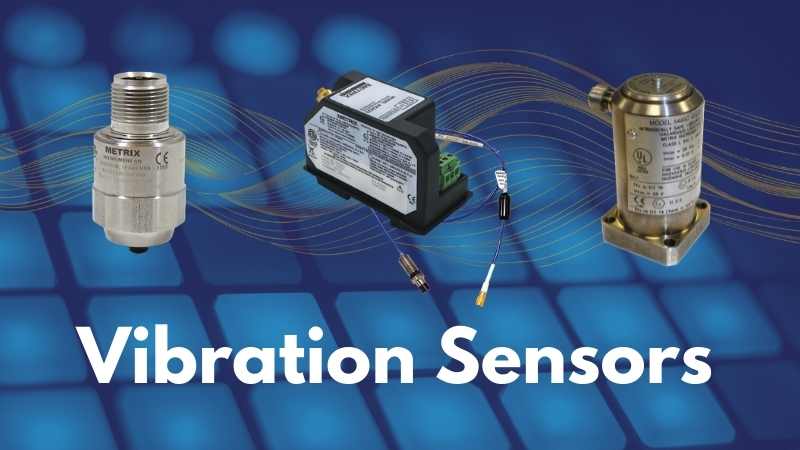Which Sensors Detect Vibration in Machinery?
When it comes to rotating and reciprocating machinery, small problems can quickly become disastrous. That's why it's crucial for any business that uses industrial machinery to install sensors that can detect these minor issues and irregularities before they evolve into something much more problematic.
Vibration sensors are the best way to catch problems within your machinery. They work by sensing vibration and identifying irregularities in a machine’s normal response. If any abnormalities are detected, the sensor can be use to alert the user before the problems can worsen or cause machine failure.
If you’re looking to install vibration sensors to avoid potentially destructive problems with your machinery, here’s what you need to know.
What Is Vibration Monitoring?
Vibration monitoring is the process of using sensors to detect the abnormal motion of a machine. Unique vibrations are characterized by frequency, amplitude, phase, and when using proximity sensors, position. Most vibration sensors combine these vibration amplitudes into what is called direct amplitude. Direct amplitude is used because it is very easy to trend, and it tells you a lot about the machine’s condition. Under steady state conditions (e.g., constant load and speed), if the direct amplitude is changing, it is usually cause for an investigation.
So, a vibration detection system monitors the direct amplitude of a machine’s vibrations and alerts the user when there is an abnormality.
Vibration sensors can be set to learn the machine’s normal vibration characteristics and alert the user or even shut off machinery altogether when irregularities are found. This can help avoid potential damage from undetected issues and prevent machine failures. In doing so, vibration sensors save businesses time, money and improve safety.
Types of Vibration Sensors
With rolling element bearing machines, accelerometers and velocity sensors are the primary tools used to measure vibration. In fluid film bearing machines (e.g., sleeve bearings, journal bearings, pressurized bearings, etc.), proximity probe sensors are the primary tools used to measure vibration. Proximity probes are also used to measure machine speed (revolutions per minute – RPM) and thrust position.
In the below sensors, we will discuss how they work to measure machine vibrations:
Piezoelectric Accelerometers
A piezoelectric vibration sensor measures a machine’s health by converting a mechanical stress into an electrical signal that can be sensed and made proportional to the machine’s acceleration. The piezo sensor works by generating a specific voltage output caused by the oscillating mechanical stress. This voltage output can then be analyzed, and any irregularities can be identified quickly. Piezoelectric accelerometers are extremely accurate vibration sensors and are compatible with a wide variety of rotating and reciprocating machinery. These vibration sensors also boast a wide frequency bandwidth.
MEMS-Based Accelerometers
Microelectromechanical system (MEMS) based accelerometers have become another choice for machinery vibration sensors. While they are getting close to becoming as accurate as piezoelectric accelerometers, they have some distinct benefits. One of the benefits MEMS-based accelerometers is that they are very small (e.g., they can fit in your cell phone). They also use a fraction of the power needed by piezoelectric devices. So, battery powered vibration sensors often use MEMS technology.
Velocity Sensors
Velocity sensors and transmitters are often used in rotating and reciprocating machines because they provide the best signal to noise ratio for the operating ranges of most machinery. For rolling element bearing machines that operate equal to or less than 60 Hz, a velocity sensor or transmitter is the vibration sensor of choice. On reciprocating machines, you often see velocity sensors or transmitters used to measure the vibration of the crankcase to provide early warning of a crankshaft fault.
Proximity Sensors
Proximity sensors are used to measure the relative motion between the rotor and the stator without coming in contact with the shaft. Because of the damping effects of the fluid wedge within the bearing, the proximity sensor is the sensor of choice to monitor the rotor’s vibration. Oftentimes with a fluid film bearing, the rotor vibration does not make it to the casing because of the shock absorbing effects of the fluid wedge within the bearing.
Finding the Best Vibration Sensor for Your Business
Choosing the right vibration sensor for your business’s machinery can be difficult — but it doesn’t have to be. When searching for a vibration sensor or transmitter, it is crucial to keep in mind the signal to noise ratio (SNR) and what exactly you want to measure.
If you want to measure casing vibration, then use an accelerometer or a velocity sensor. If you are going to measure rotor vibration, and the rotor can move relative to the stator, then use a proximity sensor. Keep in mind the frequencies of interest when choosing a sensor. One has to know the machine speed, and if appropriate, the rolling element bearing frequencies, gear mesh frequencies, pole passage frequencies, vane passage frequencies, etc. in order to choose the right vibration sensor.
Contact Metrix Vibration Today
At Metrix Vibration, we’re proud to offer a wide variety of vibration sensors for your company’s needs and we welcome the opportunity to help you pick the right sensor for your application. We have everything from accelerometers to proximity vibration sensors. Our innovative and effective technologies have been helping businesses measure vibration and prevent costly machine failures for over five decades. If you’re interested in vibration monitoring, you can trust us to provide the early warning you need to take positive corrective action and keep your equipment safe and operating, please contact us for more information.
By Everett Jesse, Vice President of Sales and Marketing

